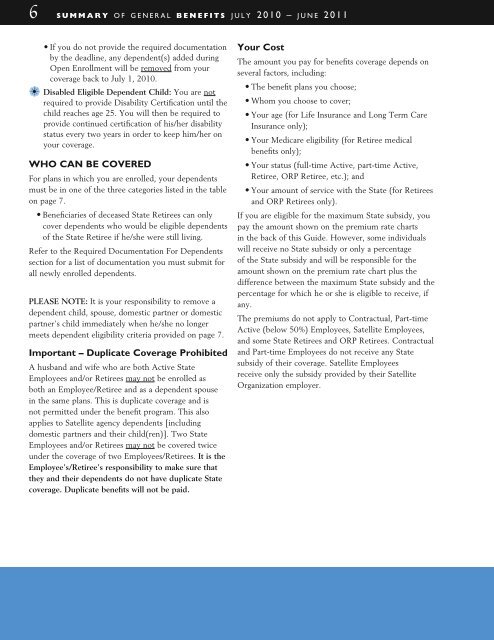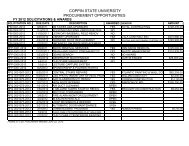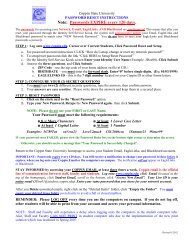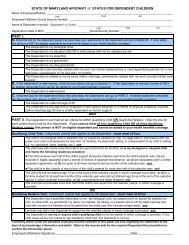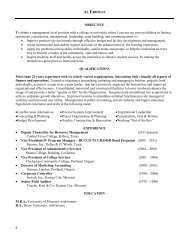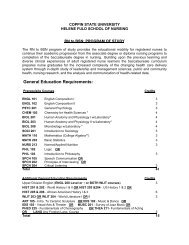FY2011 Health Benefits Booklet
FY2011 Health Benefits Booklet
FY2011 Health Benefits Booklet
You also want an ePaper? Increase the reach of your titles
YUMPU automatically turns print PDFs into web optimized ePapers that Google loves.
6 s u m m a r y o f g e n e r a l b e n e f i t s j u l y 2 0 1 0 – j u n e 2 0 1 1<br />
• If you do not provide the required documentation<br />
by the deadline, any dependent(s) added during<br />
Open Enrollment will be removed from your<br />
coverage back to July 1, 2010.<br />
a• Disabled Eligible Dependent Child: You are not<br />
required to provide Disability Certification until the<br />
child reaches age 25. You will then be required to<br />
provide continued certification of his/her disability<br />
status every two years in order to keep him/her on<br />
your coverage.<br />
Who Can BE CoverED<br />
For plans in which you are enrolled, your dependents<br />
must be in one of the three categories listed in the table<br />
on page 7.<br />
• Beneficiaries of deceased State Retirees can only<br />
cover dependents who would be eligible dependents<br />
of the State Retiree if he/she were still living.<br />
Refer to the Required Documentation For Dependents<br />
section for a list of documentation you must submit for<br />
all newly enrolled dependents.<br />
Please note: It is your responsibility to remove a<br />
dependent child, spouse, domestic partner or domestic<br />
partner’s child immediately when he/she no longer<br />
meets dependent eligibility criteria provided on page 7.<br />
Important – Duplicate Coverage Prohibited<br />
A husband and wife who are both Active State<br />
Employees and/or Retirees may not be enrolled as<br />
both an Employee/Retiree and as a dependent spouse<br />
in the same plans. This is duplicate coverage and is<br />
not permitted under the benefit program. This also<br />
applies to Satellite agency dependents [including<br />
domestic partners and their child(ren)]. Two State<br />
Employees and/or Retirees may not be covered twice<br />
under the coverage of two Employees/Retirees. It is the<br />
Employee’s/Retiree’s responsibility to make sure that<br />
they and their dependents do not have duplicate State<br />
coverage. Duplicate benefits will not be paid.<br />
Your Cost<br />
The amount you pay for benefits coverage depends on<br />
several factors, including:<br />
• The benefit plans you choose;<br />
• Whom you choose to cover;<br />
• Your age (for Life Insurance and Long Term Care<br />
Insurance only);<br />
• Your Medicare eligibility (for Retiree medical<br />
benefits only);<br />
• Your status (full-time Active, part-time Active,<br />
Retiree, ORP Retiree, etc.); and<br />
• Your amount of service with the State (for Retirees<br />
and ORP Retirees only).<br />
If you are eligible for the maximum State subsidy, you<br />
pay the amount shown on the premium rate charts<br />
in the back of this Guide. However, some individuals<br />
will receive no State subsidy or only a percentage<br />
of the State subsidy and will be responsible for the<br />
amount shown on the premium rate chart plus the<br />
difference between the maximum State subsidy and the<br />
percentage for which he or she is eligible to receive, if<br />
any.<br />
The premiums do not apply to Contractual, Part-time<br />
Active (below 50%) Employees, Satellite Employees,<br />
and some State Retirees and ORP Retirees. Contractual<br />
and Part-time Employees do not receive any State<br />
subsidy of their coverage. Satellite Employees<br />
receive only the subsidy provided by their Satellite<br />
Organization employer.


